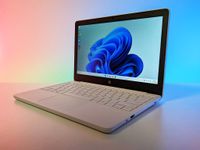Microsoft's ambitious end-to-end computing strategy may be more than it can handle

From making Azure the "world's computer" to edifice category-defining, aspirational hardware to inspire an entire industry of devices, Microsoft wants information technology all.
Microsoft'southward ubiquitous computing vision is a comprehensive end-to-terminate strategy. The visitor aims to build the cloud foundation that volition manage cantankerous-platform digital experiences across billions of enterprise and consumer devices connected to its intelligent border. And information technology'due south dedicated to providing cross-platform apps and to being a "devbox" for cantankerous-platform app development.
Complementing this cloud and software foundation, the company's hardware goals focus on supplying first- and third-party devices as "access points" to its always-expanding intelligent cloud and spider web-based products and services. No other company is every bit dedicated to creating an all-encompassing intelligent cloud platform, supplying a range of professional and personal productivity spider web-based tools like Microsoft 365, providing cross-platform apps and development platforms, and building a range of category-defining hardware.
Microsoft's arroyo is laudable, simply is it trying to exercise too much?
Microsoft'southward head in the cloud

Microsoft'due south recent reorg reveals simply how focused the company is on its deject and AI strategy. In a world that's increasingly less device-centric, where users move betwixt ecosystems and devices every day, Microsoft'due south working to provide the cloud platform that facilitates and powers users' digital experiences.
Azure supports cloud computing for hundreds of companies, runs apps for individual and big developers, stores data, streams apps and other content, is being positioned for game streaming, host's Microsoft's AI supercomputer, and more than.
Additionally, Microsoft's cloud uses Microsoft 365, Microsoft Graph and Cortana to continue users' experiences beyond devices. Azure is second just to Amazon's cloud which is a testimony to the magnitude of Microsoft'southward cloud investments. Still, Microsoft'southward Achilles Heel has historically been having "besides many irons in the burn down" resulting in hyper-focus in some areas and negligence in others.
What Microsoft's means when it says Azure is the world's calculator
IoT(eetering) on the edge

In that location are expected to be 30 billion IoT devices by 2022, and Microsoft has its middle on that prize. It's investing heavily in IoT through initiatives like Microsoft Azure IoT and border computing. As more than devices connect to the deject, and processing ability evolves, tasks that usually occur in the deject move to the edge, or the connected devices closest to the user.
Yet, Microsoft's edge computing efforts are enterprise- or backend-focused. This is good for business partnerships merely less impactful to consumers. Millions of consumers are being hooked into Google'south and Apple's ecosystems through smartphones, smart speakers and other connected consumer devices.
Microsoft'southward chasing "everything," but its canvasing approach may be negatively impacting its power to address specific consumer needs.
What is edge computing and how does it impacts mobile?
On the Surface

Hardware is the user's entry point to Microsoft's cloud and services. Afterward two failed attempts and a billion-dollar loss, Surface Pro 3 finally made Microsoft's category-defining hardware efforts successful. This success established Surface equally a loftier-end brand for both its part, attributes and aesthetics.
Surface has grown beyond the Surface Pro 2-in-1 and now encompasses the powerful Surface Volume, the digital drafting tabular array that is Surface Studio, the collaboration-focused Surface Hub and the MacBook-challenging Surface Laptop. Microsoft's rumored "Projection Andromeda" may add a digital periodical Pocket PC to this family. Additionally, though non Surface-branded, Microsoft's HoloLens inspired the industry with its ambitious, untethered, wearable-PC approach to augmented reality (AR).
As start-political party aspirational "admission points" to Microsoft's cloud, Microsoft has proven it tin can do hardware. Still, the snail's pace of HoloLens'southward market place progress, as rivals snatch AR mindshare from Microsoft's technologically superior approach, may indicate Microsoft has too much on its plate. Additionally, Lumia'due south demise, while Microsoft avant-garde its cloud infrastructure, may be further evidence that Microsoft can't handle everything it sets out to do.
More of the aforementioned?

Microsoft's end-to-end, ubiquitous calculating strategy is ambitious and comprehensive, and it reflects a calibration no other company has embarked upon. However, the fact that Google and Apple are more focused on and successful in specific areas that Microsoft competes in, may be proof that Microsoft's approach is too wide.
Additionally, an credible lack of marketing commitment, as demonstrated by the spotty marketing of Windows phones and other products, suggests Microsoft has the technical chapters to build an end-to-end solution but may lack the ability to drive the vision home.
Perhaps the maturing "One Microsoft" vision and a divergence from a "side-project" product development arroyo are the company's initial steps to being ameliorate multitaskers.
Or maybe Cortana's and the Harmon Kardon'south current consumer troubles are signs of more of the same. Only fourth dimension volition tell.
We may earn a commission for purchases using our links. Larn more.

Oh Dear
New report reveals Microsoft's hereafter AR strategy; HoloLens 3 is expressionless
Business Insider has today published a follow-up written report with more details nigh Microsoft'southward canceled HoloLens 3 augmented reality headset. The partnership with Samsung is said to include a headset with a gear up of screens within, powered past a Samsung phone in your pocket.

Keeping it affordable
Review: Surface Laptop SE is the new standard for K-viii Windows PCs
Starting at just $250, Microsoft's first foray into affordable laptops for the education market is a winner. With a gorgeous design, excellent thermals, and a fantastic typing experience, Microsoft would do right to sell this straight to consumers every bit well. Permit's just promise Intel tin can make a amend CPU.

Polish bright similar a diamond
These laptops take bright screens neat for outdoor use
Due to the never-ending war against sun glare, laptop developers have fabricated their laptop screens brighter than ever in contempo years. Hither'southward a drove of some of our favorite laptops with bright displays.
Source: https://www.windowscentral.com/microsofts-cloud-hardware-ubiquitous-computing-approach-may-more-it-can-handle
Posted by: morrisonthaven.blogspot.com


0 Response to "Microsoft's ambitious end-to-end computing strategy may be more than it can handle"
Post a Comment